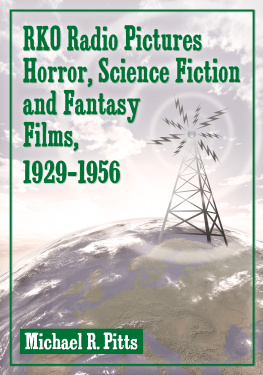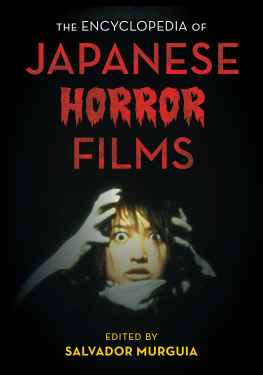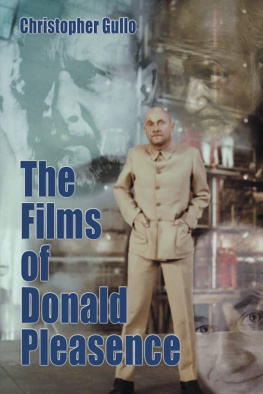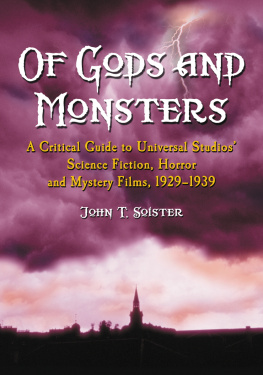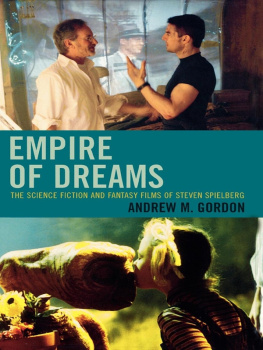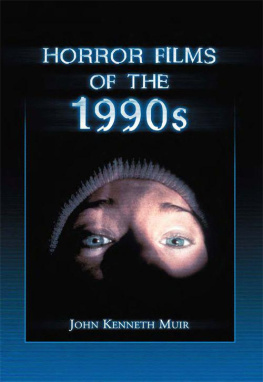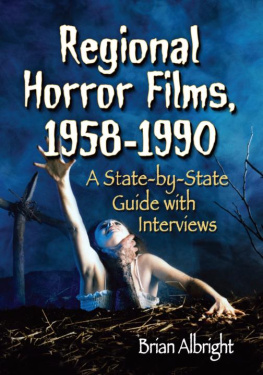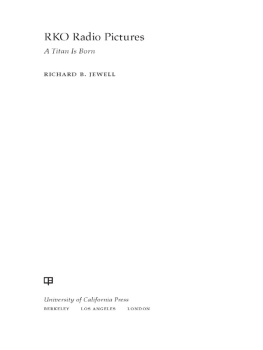
RKO Radio Pictures Horror, Science Fiction and Fantasy Films, 19291956
Michael R. Pitts

McFarland & Company, Inc., Publishers
Jefferson, North Carolina
LIBRARY OF CONGRESS CATALOGUING DATA ARE AVAILABLE
BRITISH LIBRARY CATALOGUING DATA ARE AVAILABLE
e-ISBN: 978-1-4766-1683-4
2015 Michael R. Pitts. All rights reserved
No part of this book may be reproduced or transmitted in any form or by any means, electronic or mechanical, including photocopying or recording, or by any information storage and retrieval system, without permission in writing from the publisher.
Cover images iStock/Thinkstock
McFarland & Company, Inc., Publishers
Box 611, Jefferson, North Carolina 28640
www.mcfarlandpub.com
To the memory of my cousin,
Bernadine Herkless Morgan
(19092010)
Preface
From 1929 to 1956, RKO Pictures released more than 140 feature films dealing with horror, science fiction and fantasy themes. Today, the company is mainly remembered in these genres for the classics King Kong and The Thing from Another World, but RKO also did a number of other memorable features like The Most Dangerous Game, The Phantom of Crestwood, She, The Hunchback of Notre Dame, Experiment Perilous, The Enchanted Cottage, The Spiral Staircase and Its a Wonderful Life. RKO is also known for a series of atmospheric psychological horror thrillers produced by Val Lewton, including Cat People, I Walked with a Zombie, The Seventh Victim, The Curse of the Cat People and The Body Snatcher. In the realm of fantasy, RKO served as the feature film distributor for Walt Disney Studios between 1938 and 1954, releasing the classics Snow White and the Seven Dwarfs, Fantasia, Pinocchio, Dumbo, Bambi, Cinderella, Alice in Wonderland and Peter Pan.
While RKO only made horror, science fiction and fantasy movies in the sound era, its roots date back to the silent days with these genres. RKO Radio Pictures came into being in 1929 with the merging of Film Booking Offices of America (FBO) with Radio Corporation of Americas Keith-Albee-Orpheus (KAO) theater circuit. Thus the studio had the production facilities of FBO and the Keith-Albee-Orpheum theaters needed to exhibit its product. The merger was facilitated by the head of Radio Corporation of America (RCA), David Sarnoff, who wanted an outlet for RCA Photophone, a sound-on-film process. FBO was owned by Joseph Kennedy, who had bought it in 1926; prior to 1922 it had been known as Robertson-Cole. In 1927 KAO merged Path Exchange and Producers Distributing Corporation (PDC), which was owned by Cecil B. DeMille, and this conglomerate also became a part of RKO Radio Pictures. RKO bought Path from Kennedy in 1931, obtaining its Culver City studio and backlot.
Path had a fairly lengthy involvement with horror-related features and serials. A production and distribution company from 1921 to 1927, it was founded in 1910 by Path, a French company that had been distributing its films stateside since 1900. By 1914 the U.S. operation was known as Path Frres and it became independent in 1921, calling itself Path Exchange. Between 1915 and 1930, Path was involved in the production of some 475 titles.
One of Paths first genre-related features was The House of Fear (1915), the third in a series based on John T. McIntyres short stories about sleuth Ashton-Kirk, played by Arnold Daly. This outing had the famed detective trying to unravel mysterious happenings in an old house, eventually finding a series of tunnels used by counterfeiters. Veteran serial villain Sheldon Lewis co-starred and the leading lady was future Broadway star Jeanne Eagels. In 1917 Path distributed Thanhouser Film Corporations production of Wilkie Collins The Woman in White, starring Florence LaBadie and Richard R. Neill. The next year Path issued the Anderson-Brunton Company feature The Ghost of the Rancho in which a dissipated young man (Bryant Washburn) redeems himself by pretending to be a ghost and protecting the woman he loves (Rhea Mitchell) from Mexican bandits. The year 1918 saw Path releasing another Anderson-Brunton film, The Bells, starring Frank Keenan and Lois Wilson. It told of an innkeeper (Keenan) murdering a wealthy man and years later being driven mad by the sound of bells after fearing a mesmerist will make him confess to the crime. Chadwick did another version of the Henry Irving story in 1926 starring Lionel Barrymore with Boris Karloff as the mesmerist. In 1919 Path issued the first of three screen versions of Bayard Veillers play The Thirteenth Chair. Starring Yvonne Delva and Creighton Hale, it was an involved tale of murder and blackmail featuring a clairvoyant and sances. MGM remade it in 1929 and 1937.
The House of the Tolling Bell, a J. Stuart Blackton Feature Pictures production, was released by Path in 1920. Blackton directed this old house thriller in which May McAvoy and Bruce Gordon agree to spend a year in a spooky mansion in order to receive an inheritance from a rich relative (Anthony Cole). Another relation (William R. Dunn) plans to do them in for the money but the supposed deceased rises from his coffin, scaring off the villain, and blessing the soon-to-be-betrothed young people, who become his heirs. The same year Path co-distributed (with W.W. Hodkinson) Robert Brunton Productions The House of Whispers, headlining J. Warren Kerrigan and Fritzi Brunette. Kerrigan played a man who moves into his uncles apartment in an house that is plagued by strange noises, including screams and whispering. He finds the place is riddled with secret passages and eventually uncovers a plan by a supposedly dead man (Fred C. Jones) to drive his wife (Marjorie Wilson) mad so he and his first wife (Claire DuBrey) can get her money.
Path was also involved in the production and distribution of a number of serials with horrific elements. Pearl White starred in the most famous of all movie serials, The Perils of Pauline (1914), a 20-episode affair. Following this immensely popular, but somewhat crude, production, Path teamed with the Star Company to make a trio of serials starring White, Exploits of Elaine (1914), The New Exploits of Elaine and The Romance of Elaine (both 1915), with Arnold Daly as Arthur B. Reeves scientific detective Craig Kennedy and Creighton Hale as his associate, Walter Jameson. These chapterplays introduced the menace of the super-villain, which became a standard fixture in the serial genre. With Balboa Feature Film Corporation, Path made The Red Circle (1915) about a young woman (Ruth Roland) who is cursed to commit crimes, but is redeemed by the love of a detective (Frank Mayo). The Mysteries of Myra (1916) is an all-out horror cliffhanger starring Jean Sothern as a young woman terrorized by a cult of magicians, the Black Order, who dwell in an underground city, practice the occult arts, and use a female vampire and a thought monster to carry out their schemes. The masked hero character first appeared in The Iron Claw (1916) with White as a young woman in the clutches of the title villain and saved by the mystery man. There was a science fiction element to the plot of PathAstra Films The Shielding Shadow (1916) with the hero (Ralph Kellard) becoming invisible via a mysterious pellet; Grace Darmond was the leading lady. Invisibility courtesy of an ancient Egyptian violet diamond was the central plot ploy of
Next page
